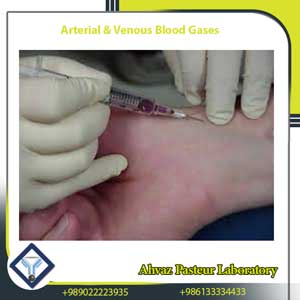
Arterial and Venous Blood Gases
Arterial and venous blood gas testing is one of the most important tests required by the intensive care unit and provides valuable information for evaluating and adopting appropriate measures for the state of homeostasis of electrolytes and acid and metabolic and respiratory opening of the patient.
This test is typically done on a blood sample taken from the radial artery in the inner wrists below the thumb where the beats feel the copper. Blood samples can also be collected from the arterial artery in the elbow or femoral artery in the groin.
pH
Natural blood pH is between 7,35 and 4,7. pH in metabolic or respiratory alkalosis is higher than pH 7.4 and in the respiratory or metabolic acidosis, the pH is reduced to less than 7.35.
PCO2
Indicates the amount of carbon dioxide contained in arterial blood. PCO2 is a criterion for the condition of the body’s body. By increasing the speed and depth of the patient’s respiration, a greater amount of CO2 is released and its surface is reduced. The CO2 level is proportional to the pH of the blood.
In metabolic alkalosis, the lungs try to compensate for and reduce pH with CO2 retention.

arterial blood gases
HCO3 or CO2 content
Most of the CO2 content in the blood is -HCO3. The bicarbonate ion represents the metabolic part of the acid balance and is open and under the regulation of the kidneys. As bicarbonate levels increase, pH also increases, so bicarbonate has a direct relative pH.
The natural amount of bicarbonate ion is between 21 and 28 milliqls / liter.
PO2
Dissolves oxygen in the blood. This pressure determines the force of O2 to propagate through the lung alveolar membrane. In normal mode, it is between 100 and 80 mmHg. The pressure level is less than 40 mm Hg, and the values below 40 mm Hg are very dangerous.
O2 content
Indicates the amount of O2 in the blood. Which is calculated by the formula according to the formula. O2 content is reduced in diseases that reduce PO2.
- Allen test should be performed before blood sampling.
- Arterial blood can be taken from anywhere in the body with a potentially tangible pulse.
- After blood, pressurize the artery for 3-5 minutes.
- Remove the air bubbles inside the syringe.
- Arterial blood is placed on ice and sent immediately to the lab.
Allen test
To do this test, block both the radial and ulnar pulses with the pressure to allow the patient to whiten, then remove the pressure from the ulnar artery if the ulnar arterial flow is appropriate, the hand is immediately red, then the Allen test is positive and you can Use radial artery to collect blood.
If the Allen test is negative, do the test on the other hand. If Allen’s test result is both negative, choose another artery for sampling.
Normal range:
pH
ADULTS / CHILDREN: 1.2 – 1.8%
Newborns: 4.1 – 4.1
From 1 month to 2 years old: 4.1-6.1
pH (Intravenous): 1.5 –
PCO2
Adults / children: 4-6 mmHg
Children under two years of age: 1-5 mmHg
Pco2 (intravenous): 40- 50 mmHg
HCO3
ADULTS / CHILDREN: 2-4 milligrams per liter
Children under 4 years: 1-3 milligrams per liter
PO2
Adults / children: 4-6 mmHg
Newborns: 1-7 mmHg
Po2 (venous): 40- 50 mmHg
O2 saturation
Adults / children: 4-5%
Elderly: 1%
Infants 1–5%
